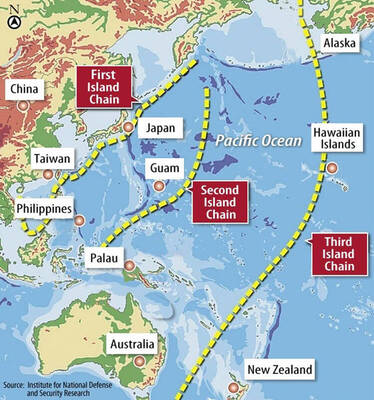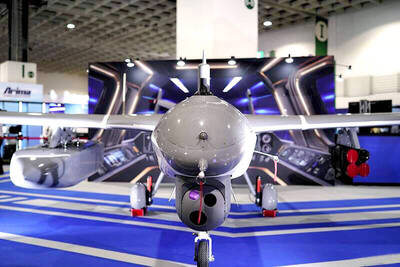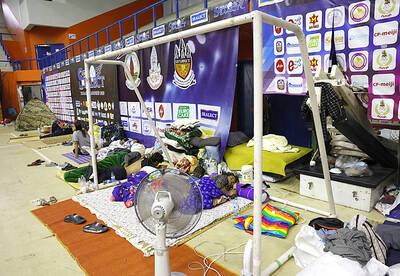China’s defense budget is to rise 8.1 percent to 1.1 trillion yuan (US$175.1 billion) this year as the nation prepares to launch its second aircraft carrier, integrate stealth fighters into its air force and field an array of advanced missiles able to attack air and sea targets at vast distances.
The figure released in a report yesterday to the 13th National People’s Congress is an increase in the growth rate from last year, when officials said the budget was rising 7 percent to 1 trillion yuan.
“We will stick to the Chinese path in strengthening our armed forces, advance all aspects of military training and war preparedness,” Chinese Premier Li Keqiang (李克強) said.

Photo: EPA
China has the world’s largest military by number of personnel, but Li said the nation had “basically completed” the target of reducing the size of the armed forces by 300,000 troops. That would leave the Chinese People’s Liberation Army’s strength at about 2 million troops.
However, China’s defense spending as a share of GDP and the budget remains lower than that of other major nations, congress spokesman Zhang Yesui (張業遂) said on Sunday.
This year’s defense budget comes to about 1.3 percent of last year’s GDP.
Analysts do not consider China’s publicly announced defense spending to be entirely accurate, since defense equipment projects account for a significant amount of “off-book” expenditures.
Noting that this year’s increase was roughly the same as last year’s when adjusted for inflation, Shanghai military expert Ni Lexiong (倪樂雄) said that China is seeking to avoid a full-on arms race based on quantity of weapons, choosing instead to invest in high-tech systems and training.
China’s defense budget is so large that double-digit annual percentage increases are no longer necessary, military commentator Song Zhongping said.
New funds are going mainly to raise living standards for service members, increase training and prepare for potential crises on the Korean Peninsula, the border with India or in the South China Sea or Taiwan Strait, Song said.
Much of China’s energies have been focused on what is known as anti-access/area denial operations, which seek to scare the US Navy and other forces far from China’s shores.
All three of China’s sea forces — the navy, coast guard and maritime militia — are the largest of their types by number of ships, allowing them to “maintain presence and influence in vital seas,” said Andrew Erickson of the US Naval War College’s China Maritime Studies Institute.
All three fleets are growing “leaner and meaner” due to a greater emphasis on technical sophistication, Erickson wrote, adding that the US also anticipates facing a Chinese submarine fleet twice its number, although less technologically advanced.
In the air, China last month said it had begun equipping combat units with its J-20 stealth fighters.
No less impressive is its missile technology, particularly the DF-21D, which is built to take out an aircraft carrier, and a new air-to-air missile with a range of about 400km that could attack assets such as early warning aircraft and refueling tankers crucial to US Air Force operations.
Meanwhile, Li said that China would never tolerate any separatist schemes for Taiwan and would safeguard its territorial integrity with the aim of “reunification.”
Li issued the warning in his speech at the congress’ opening amid mounting Chinese anger over a US bill that seeks to raise official contacts between Washington and Taipei.
China would promote the peaceful growth of relations across the Taiwan Strait and “advance China’s peaceful reunification,” Li said.
“As fellow Chinese living on both sides of the Taiwan Strait, we share a bond of kinship. As long as we go with the tide of history and work together for our nation’s greater good, we will together create the future — a beautiful future of national rejuvenation,” he added.
China would also continue to implement to the letter the “one country, two systems” method of rule for Hong Kong and Macau, Li said.
Additional reporting by Reuters

The US government has signed defense cooperation agreements with Japan and the Philippines to boost the deterrence capabilities of countries in the first island chain, a report by the National Security Bureau (NSB) showed. The main countries on the first island chain include the two nations and Taiwan. The bureau is to present the report at a meeting of the legislature’s Foreign Affairs and National Defense Committee tomorrow. The US military has deployed Typhon missile systems to Japan’s Yamaguchi Prefecture and Zambales province in the Philippines during their joint military exercises. It has also installed NMESIS anti-ship systems in Japan’s Okinawa

‘WIN-WIN’: The Philippines, and central and eastern European countries are important potential drone cooperation partners, Minister of Foreign Affairs Lin Chia-lung said Minister of Foreign Affairs Lin Chia-lung (林佳龍) in an interview published yesterday confirmed that there are joint ventures between Taiwan and Poland in the drone industry. Lin made the remark in an exclusive interview with the Chinese-language Liberty Times (the Taipei Times’ sister paper). The government-backed Taiwan Excellence Drone International Business Opportunities Alliance and the Polish Chamber of Unmanned Systems on Wednesday last week signed a memorandum of understanding in Poland to develop a “non-China” supply chain for drones and work together on key technologies. Asked if Taiwan prioritized Poland among central and eastern European countries in drone collaboration, Lin

Renewed border fighting between Thailand and Cambodia showed no signs of abating yesterday, leaving hundreds of thousands of displaced people in both countries living in strained conditions as more flooded into temporary shelters. Reporters on the Thai side of the border heard sounds of outgoing, indirect fire yesterday. About 400,000 people have been evacuated from affected areas in Thailand and about 700 schools closed while fighting was ongoing in four border provinces, said Thai Rear Admiral Surasant Kongsiri, a spokesman for the military. Cambodia evacuated more than 127,000 villagers and closed hundreds of schools, the Thai Ministry of Defense said. Thailand’s military announced that

CABINET APPROVAL: People seeking assisted reproduction must be assessed to determine whether they would be adequate parents, the planned changes say Proposed amendments to the Assisted Reproduction Act (人工生殖法) advanced yesterday by the Executive Yuan would grant married lesbian couples and single women access to legal assisted reproductive services. The proposed revisions are “based on the fundamental principle of respecting women’s reproductive autonomy,” Cabinet spokesperson Michelle Lee (李慧芝) quoted Vice Premier Cheng Li-chiun (鄭麗君), who presided over a Cabinet meeting earlier yesterday, as saying at the briefing. The draft amendment would be submitted to the legislature for review. The Ministry of Health and Welfare, which proposed the amendments, said that experts on children’s rights, gender equality, law and medicine attended cross-disciplinary meetings, adding that